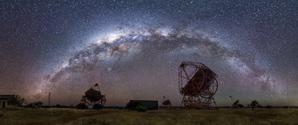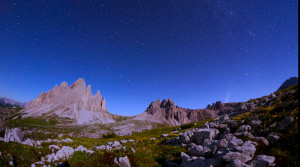Glossary term: Ciel
Description: Le ciel est ce que nous voyons lorsque nous sommes à l'extérieur, notre vue n'étant encombrée par aucune structure sur Terre, regardant vers le haut ou au moins plus haut que l'horizon qui marque la limite de ce que nous pouvons voir de la Terre et des structures terrestres. La nuit, lorsque le ciel est dégagé, nous pouvons voir des planètes lointaines, des étoiles et même quelques galaxies (la galaxie d'Andromède dans l'hémisphère nord et les nuages de Magellan dans l'hémisphère sud). Le scintillement des étoiles prouve que nous regardons encore à travers les gaz de l'atmosphère terrestre. Pendant la journée, la lumière du soleil dispersée par les molécules d'air fait briller le ciel d'une couleur bleue, bloquant notre vue sur le cosmos. Les nuages ou le brouillard qui couvrent le ciel nous empêchent également d'observer les objets astronomiques.
Related Terms:
See this term in other languages
Term and definition status: The original definition of this term in English have been approved by a research astronomer and a teacher The translation of this term and its definition is still awaiting approval
The OAE Multilingual Glossary is a project of the IAU Office of Astronomy for Education (OAE) in collaboration with the IAU Office of Astronomy Outreach (OAO). The terms and definitions were chosen, written and reviewed by a collective effort from the OAE, the OAE Centers and Nodes, the OAE National Astronomy Education Coordinators (NAECs) and other volunteers. You can find a full list of credits here. All glossary terms and their definitions are released under a Creative Commons CC BY-4.0 license and should be credited to "IAU OAE".
If you notice a factual or translation error in this glossary term or definition then please get in touch.
Related Media
Voie Lactée Au-dessus de l'Arbre à Carquois
Credit: Jianfeng Dai/IAU OAE (CC BY 4.0)
License: CC-BY-4.0 Creative Commons Attribution 4.0 International (CC BY 4.0) icons
Milky Way Over H.E.S.S Observatory
Credit: Jianfeng Dai/IAU OAE (CC BY 4.0)
License: CC-BY-4.0 Creative Commons Attribution 4.0 International (CC BY 4.0) icons
Big Dipper and Comet Neowise C2020 F3
Credit: Giorgia Hofer/IAU OAE (CC BY 4.0)
License: CC-BY-4.0 Creative Commons Attribution 4.0 International (CC BY 4.0) icons
Southern Sky Over La Silla
Credit: José Rodrigues/IAU OAE (CC BY 4.0)
License: CC-BY-4.0 Creative Commons Attribution 4.0 International (CC BY 4.0) icons












